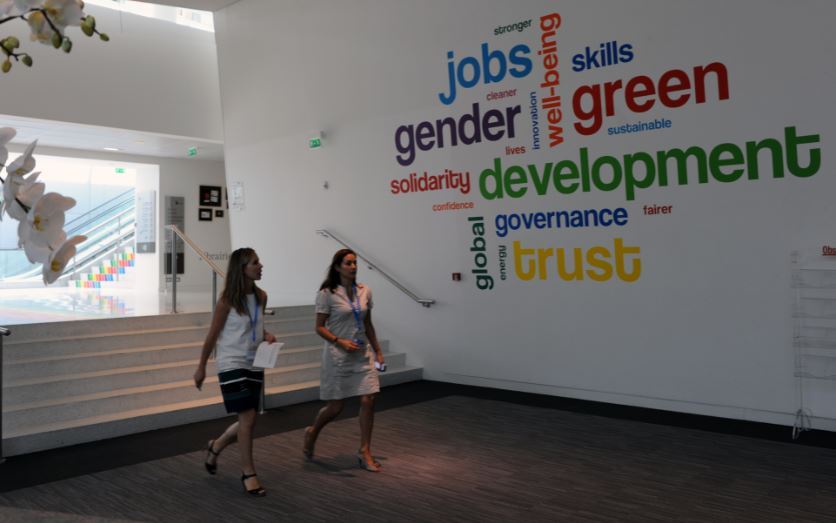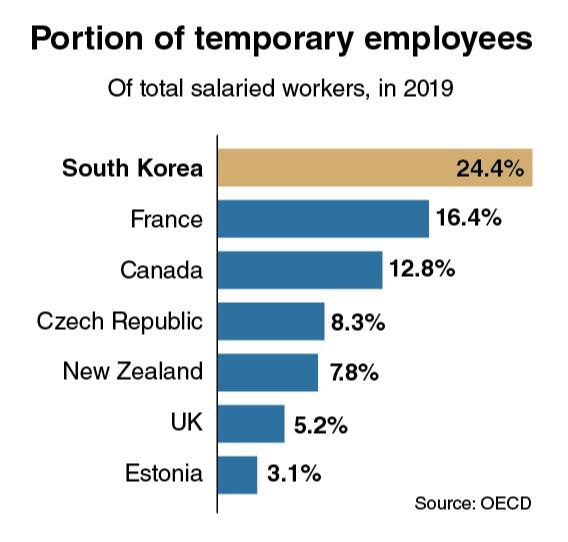[News Focus] Korea 4th most reliant on temporary labor in 2019, up from 7th in 2018
OECD comparison highlights lack of job security in Korea
By Kim Yon-sePublished : July 14, 2020 - 11:29

SEJONG -- Relative to all salaried workers in South Korea, the percentage of temporary workers increased 3.2 percentage points in just one year -- from 21.2 percent in 2018 to 24.4 percent in 2019, data from the Organization for Economic Cooperation and Development showed.
As a result, in 2019 Korea was fourth on the list of OECD countries with the highest percentage of temporary workers -- up from No. 7 a year earlier. Only 34 of the OECD’s 37 members were included in the comparison.
Over that one year Korea overtook the Netherlands (20.3 percent), Portugal (20.8 percent) and Poland (21.8 percent) in its level of reliance on temporary labor.
A temporary employee refers to a salaried worker whose job has a predetermined termination date. People in this category are classified as nonregular workers in the local hiring market, alongside contract workers and part-time workers.
The figure for Korea is quite high compared to the European Union average of 13.6 percent, the OECD average of 11.8 percent and the Group of Seven average of 8.8 percent.

While the US and the UK posted only 4 percent and 5.2 percent, respectively, many emerging economies posted figures lower than Korea’s.
Slovenia stood at No. 12 on the list, with temporary workers making up 13.4 percent of all salaried workers. Others with fewer temporary workers in proportion to their salaried workforces were Turkey (12.6 percent), Greece (12.5 percent), the Czech Republic (8.3 percent), Slovakia (8.2 percent) and Hungary (6.6 percent).
Among those countries that recorded figures under 5 percent were the Baltic countries -- Latvia (3.2 percent), Estonia (3.1 percent) and Lithuania (1.5 percent).
Countries whose figures were under the OECD average also included Belgium with 10.9 percent, Ireland with 9.8 percent, Luxembourg with 9.2 percent, Norway with 8 percent, New Zealand with 7.8 percent, Iceland with 7.8 percent and Australia with 5.3 percent.
A labor research analyst said the OECD comparison shows the relative lack of job security in Korea. “While the official jobless rate of 4.5 percent as of May means the number of unemployed stayed at only 1.27 million, the number of de facto unemployed people (including the underemployed) has reached 4.36 million with the extended jobless rate of 14.5 percent.”
According to a recent joint survey by recruiting portal Job Korea, more than 30 percent of salaried workers in their 20s and 30s started out as nonregular workers.
The poll also showed that about 48 percent of high school graduates were nonregular workers -- holding temporary, contract or part-time jobs -- when they were initially hired. More than 1 in 4 college graduates were in the same situation.
According to data from Statistics Korea, the number of nonregular workers -- the broader category that includes temporary workers -- has continued to increase, posting 6.57 million in August 2017, 6.61 million in August 2018 and 7.48 million in August 2019.
In contrast, the number of regular workers remained flat during the first year of President Moon Jae-in’s term, recording 13.42 million in August 2017 and 13.43 million in August 2018. But as of August 2019, the most recent month for which Statistics Korea has statistics available, it had slid to 13.07 million.
This data indicates that the number of regular jobs fell by 350,000, while the number of nonregular jobs increased by more than 900,000 over the corresponding two years.
As a result, the proportion of nonregular workers among salaried employees has risen to 36.4 percent -- the highest it has been since March 2007, when it was 36.6 percent.
Though the government agency makes the relevant data public only once or twice a year, in March or August, the figure stayed under 33 percent between 2013 and 2016.
By Kim Yon-se (kys@heraldcorp.com)




![[Herald Interview] 'Amid aging population, Korea to invite more young professionals from overseas'](http://res.heraldm.com/phpwas/restmb_idxmake.php?idx=644&simg=/content/image/2024/04/24/20240424050844_0.jpg&u=20240424200058)












![[KH Explains] Korean shipbuilding stocks rally: Real growth or bubble?](http://res.heraldm.com/phpwas/restmb_idxmake.php?idx=652&simg=/content/image/2024/04/25/20240425050656_0.jpg&u=)

